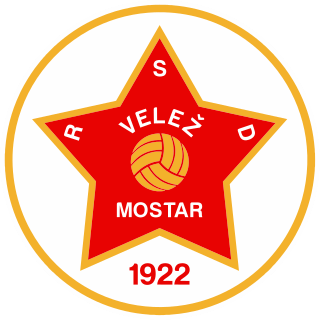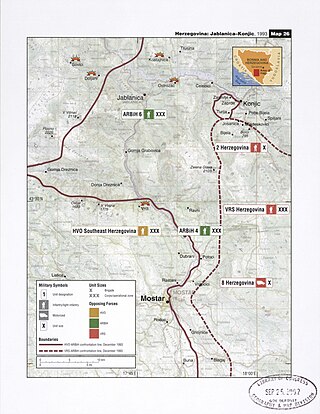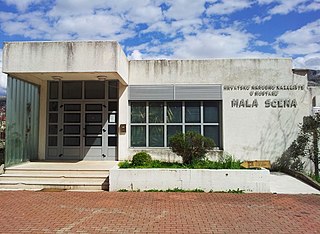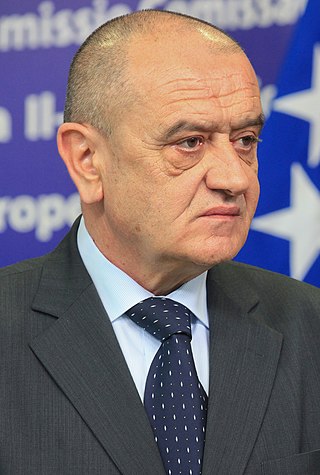Mostar Youth Theatre 1974. is an independent community theatre group in Mostar, Bosnia and Herzegovina. It was founded by Sead Dulic in 2011 and is the offshoot of city-owned Mostar Youth Theatre. It was formed after the City of Mostar raised charges against former Mostar Youth Theatre director, Sead Dulic, and resolved him of his directorial duties. [1]
In 2011 Sead Dulic, along with several actors and employees, formed Mostar Youth Theatre 1974 which continued producing plays, touring shows, and holding theatre workshops. [2] [3] [4]

The Herzegovina-Neretva Canton is one of 10 cantons of the Federation of Bosnia and Herzegovina in Bosnia and Herzegovina.

Dragan Čović is a Bosnian Croat politician who served as the 4th Croat member of the Presidency of Bosnia and Herzegovina from 2002 to 2005 and from 2014 to 2018. He is the current president of the Croatian Democratic Union and is a member of the national House of Peoples.

Mostar is a city and the administrative center of Herzegovina-Neretva Canton of the Federation of Bosnia and Herzegovina, an entity of Bosnia and Herzegovina, and the historical capital of Herzegovina.

Fudbalski klub Sloboda Tuzla is a Bosnian professional football club based in Tuzla, Bosnia and Herzegovina. The English translation of the team's name is Football Club Freedom Tuzla.

Stadion pod Bijelim brijegom, also known as HŠK Zrinjski Stadium, is a City of Mostar owned association football stadium, located in the city of Mostar, Bosnia and Herzegovina. The venue is currently home of HŠK Zrinjski Mostar. Today it has a capacity of 9,000 seats.

Stari Most, also known as Mostar Bridge, is a rebuilt 16th-century Ottoman bridge in the city of Mostar in Bosnia and Herzegovina that crosses the river Neretva and connects the two parts of the city. On 9 November 1993 Stari Most collapsed due to shelling by the Croatian Defence Council (HVO) during the Croat–Bosniak War. Subsequently, a project was set in motion to reconstruct it; the rebuilt bridge opened on 23 July 2004. In 2017, the appeal court deemed that destruction was legal since the bridge was a military target as the opposing Army of the Republic of Bosnia and Herzegovina used it as a military supply line.

Fudbalski klub Velež Mostar is a professional football club based in Mostar, Bosnia and Herzegovina. The club has a history of being one of the most successful clubs from Bosnia and Herzegovina. It was founded on 26 June 1922. The club currently plays at Rođeni Stadium, but its historic stadium is the Bijeli Brijeg. Due to the divisions between Bosniak and Croat territories, Velež lost its previous home ground of Bijeli Brijeg. That stadium was largely used by Velež during the glory days of the club, when they triumphed in the 1981 and 1986 Yugoslav Cups. The club also reached the quarter-final stage of the 1974–75 UEFA Cup.

Tourism in Bosnia and Herzegovina is a fast-growing sector making up an important part in the economy of the country.

The Croatian Republic of Herzeg-Bosnia was first a geopolitical entity and then an unrecognized quasi-state in Bosnia and Herzegovina. It was proclaimed on 18 November 1991 under the name Croatian Community of Herzeg-Bosnia as a "political, cultural, economic and territorial whole" in the territory of Bosnia and Herzegovina, and abolished on 14 August 1996.

Operation Neretva '93 was an Army of the Republic of Bosnia and Herzegovina (ARBiH) operation against the Croatian Defence Council (HVO) in September 1993 on a 200 km long front from Gornji Vakuf to south of Mostar, one of its largest of the year, during the Croat–Bosniak War. The ARBiH made limited gains in the area of northern Herzegovina and around Mostar, but did not achieve a breakthrough to the southern Neretva, where the HVO retained control. The operation was halted in October. During the operation, dozens of Croat civilians were killed in the Grabovica and Uzdol massacres.

The Croatian National Theatre in Mostar is a theatre located in Mostar, home to the largest population of Croats in Bosnia and Herzegovina.
Sead Kajtaz is a Bosnian retired footballer and manager. He was capped once for the Yugoslavia national football team. He is the father of Croatian swimmer Amina Kajtaz.
The Bosnian Footballer of the Year, since 2008 renamed to Idol Nacije, is an annual award given to the best Bosnian football player of the year, as well as recognising and awarding other sports men and women, coaches and game officials in the country. The event was held in 2001 under the Bosnian banner for the first time, with Sergej Barbarez winning the most prestigious award for best player of the year, and again in 2003.

Centuries before the Ottoman conquest of Bosnia, Mostar was a small hamlet situated at a strategic crossing of the Neretva river. Its hinterlands consisted of a broad agricultural plain on the west bank and steep terraces on the east bank surrounded by barren mountains. Mostar was a representative multi-ethnic and multi-cultural settlement in Bosnia and Herzegovina, which had possessed an independent political identity since the twelfth century. By the fifteenth century, most of the lands that would later become part of modern Yugoslavia were inhabited primarily by peoples of the same south Slavic heritage.

HŠK Zrinjski Mostar is a professional football club, based in Mostar, Bosnia and Herzegovina. The club plays in the Premier League of Bosnia and Herzegovina, and has been one of the top teams in the country over the last few years. With eight championships won in the Premier League of Bosnia and Herzegovina, Zrinjski is one of the most decorated football clubs in Bosnia and Herzegovina. The club plays its home matches at Stadion pod Bijelim Brijegom in Mostar. Zrinjski's fans are called Ultras Mostar and the fan club was founded in 1994.

Mostar Youth Theatre is a city-sponsored community theatre located in Mostar, Bosnia and Herzegovina.

Vjekoslav Bevanda is a Bosnian Croat politician who served as Chairman of the Council of Ministers of Bosnia and Herzegovina from 2012 to 2015. He was subsequently the Minister of Finance and Treasury from 2015 to 2023.

The siege of Mostar was fought during the Bosnian War first in 1992 and then again later in 1993 to 1994. Initially lasting between April 1992 and June 1992, it involved the Croatian Defence Council (HVO) and the Army of the Republic of Bosnia and Herzegovina (ARBiH) fighting against the Serb-dominated Yugoslav People's Army (JNA) after Bosnia and Herzegovina declared its independence from Yugoslavia. That phase ended in June 1992 after the success of Operation Jackal, launched by the Croatian Army (HV) and HVO. As a result of the first siege around 90,000 residents of Mostar fled and numerous religious buildings, cultural institutions, and bridges were damaged or destroyed.

Gimnazija Mostar is a gymnasium in Mostar, Bosnia and Herzegovina. Formerly called Gimnazija "Aleksa Šantić" in honour of the eponymous poet, it is nowadays popularly referred to as Stara gimnazija.
Operation Jackal, also known as Operation June Dawns, was an offensive of the Bosnian War fought between a combined Croatian Army (HV) and Croatian Defence Council (HVO) army against the Army of Republika Srpska (VRS) from 7–26 June 1992. The offensive was a Croatian pre-emptive strike against the VRS, a Bosnian Serb military formed in May 1992 from Yugoslav People's Army (JNA) units that were stationed in Bosnia and Herzegovina. The HV concluded that the JNA offensive operations of April and May 1992, resulting in the capture of Kupres and much of the Neretva River valley south of Mostar, were aimed at capturing or threatening the Croatian Port of Ploče and possibly Split. To counter this threat, the Croatian leadership deployed the HV, under the command of General Janko Bobetko, to the "Southern Front" including the area in which Operation Jackal was to be conducted.